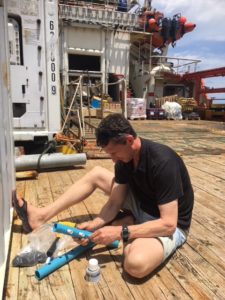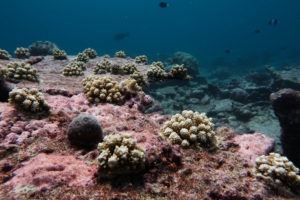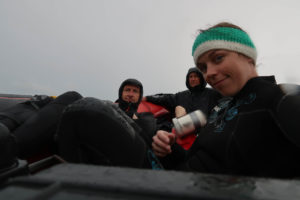This is a series of updates from #ExeterMarine researcher, Dr Ines Lange, who is on a research expedition in the British Indian Ocean Territory with Professor Chris Perry, the Bertarelli Foundation and ZSL.

03/05/2018 Somewhere in the Indian Ocean
We are in the Central Indian Ocean, sailing south on the “Grampian Frontier”. Prof. Chris Perry and myself, Dr. Ines Lange, from the Geography department are on a research cruise to study the coral reef ecosystems of the British Indian Ocean Territory (BIOT). The project is part of a large expedition funded by the Bertarelli Foundation and on board are twelve scientist, working on six different projects.
Chris and I are studying the carbonate budgets of coral reefs around islands of the Chagos archipelago. The “ReefBudget” method we use was developed by Chris and calculates how much carbonate is produced by corals and calcifying algae, and how much is eroded by grazing sea urchins and fish, as well as by internal bioeroders such as boring worms and microorganisms. The results provide a metric of reef “health” in terms of whether it is growing or eroding. On this trip we have two main goals:
1) To revisit sites that were surveyed in 2015, before the severe bleaching event that hit the Central Indian Ocean in 2016. We expect to see dramatically reduced rates of carbonate production due to low coral cover.
2) To investigate local rates of coral and calcifying algal growth as well as internal erosion rates by deploying experimental substrates.
On the two-day transit from the Maldives down to Chagos we are busy preparing material for the deployment of experimental substrates and discussing calculations for the model. Of course we also have to include a few safety exercises; it is very hot here so I would not mind going for a swim, but we ended up not abandoning the ship…
Stay tuned for our upcoming adventures underwater.
Survivors in the reef
 News from the “Reef team” in the Indian Ocean. The sites in the Salomon and Peros Banhos Atolls we visited so far show a dramatically reduced coral cover due to the severe bleaching event in 2016, causing carbonate production rates to drop to about a third of the values in 2015. On the upside, there are many Porites and also some Acropora colonies that apparently survived the bleaching, and large numbers of small recruits of different genera. Especially in the understory of the reef structure we find many live encrusting corals. Also, the substrate is quite clean of macroalgae, thanks to the high abundance of grazing herbivorous fish. Calcareous algae covering the dead coral substrate continue to produce substantial amounts of carbonate which help “glue” the existing structure together and offer a great substrate for further coral recruitment. We therefore hope we can see a fast recovery of the once glorious reefs over the next years.
News from the “Reef team” in the Indian Ocean. The sites in the Salomon and Peros Banhos Atolls we visited so far show a dramatically reduced coral cover due to the severe bleaching event in 2016, causing carbonate production rates to drop to about a third of the values in 2015. On the upside, there are many Porites and also some Acropora colonies that apparently survived the bleaching, and large numbers of small recruits of different genera. Especially in the understory of the reef structure we find many live encrusting corals. Also, the substrate is quite clean of macroalgae, thanks to the high abundance of grazing herbivorous fish. Calcareous algae covering the dead coral substrate continue to produce substantial amounts of carbonate which help “glue” the existing structure together and offer a great substrate for further coral recruitment. We therefore hope we can see a fast recovery of the once glorious reefs over the next years.
 To investigate local bioerosion rates in the reefs we had a “fun” day sawing 1000s of blocks from dead Porites skeleton (well, it certainly felt like that, on my last count it was actually 28). Today we successfully deployed the substrates in the reef, where they will be settled by encrusting and bioeroding organisms (or eaten by parrotfish? Hope not …). The work days are long and it’s actually not always as sunny as you would imagine (see how we enjoy our surface interval in the rain?!). But the company is great, and encounters with curious turtles, dancing eagle rays and confused birds trying to land on our heads make every day a great adventure…
To investigate local bioerosion rates in the reefs we had a “fun” day sawing 1000s of blocks from dead Porites skeleton (well, it certainly felt like that, on my last count it was actually 28). Today we successfully deployed the substrates in the reef, where they will be settled by encrusting and bioeroding organisms (or eaten by parrotfish? Hope not …). The work days are long and it’s actually not always as sunny as you would imagine (see how we enjoy our surface interval in the rain?!). But the company is great, and encounters with curious turtles, dancing eagle rays and confused birds trying to land on our heads make every day a great adventure…
#ExeterMarine is an interdisciplinary group of marine related researchers with capabilities across the scientific, medical, engineering, humanities and social science fields. If you are interested in working with our researchers or students, contact Michael Hanley or visit our website!
